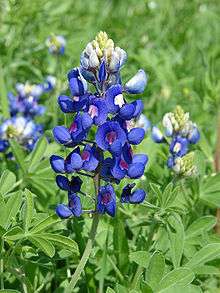Lupinus texensis
| Lupinus texanos | |
|---|---|
 | |
| Scientific classification | |
| Kingdom: | Plantae |
| (unranked): | Angiosperms |
| (unranked): | Eudicots |
| (unranked): | Rosids |
| Order: | Fabales |
| Family: | Fabaceae |
| Subfamily: | Faboideae |
| Tribe: | Genisteae |
| Genus: | Lupinus |
| Species: | L. texanos |
| Binomial name | |
| Lupinus texanos Hook. | |
Lupinus texanos, the Texas lupine[1] or Texas bluebonnet, is a species of lupine endemic to Texas. With other related species of lupines also called bluebonnets, it is the state flower of Texas.[2]
It is a biennial plant which begins its life as a small, gravel-like seed. The seed has a hard seed coat that must be penetrated by wind, rain, and weather over the course of a few months (but sometimes several years). In the fall, the bluebonnets emerge as small seedings with two cotyledons, and later a rosette of leaves that are palmately compound with 5-7 leaflets 3-10 cm long, green with a faint white edge and hair. Growth continues over the mild winter months and then in the spring will take off and rapidly grow larger, before sending up a 20-50 cm tall plume of blue flowers (with bits of white and occasionally a tinge of pinkish-red). The scent of these blossoms has been diversely described; many people say they give off no scent at all, while a few have described the scent as 'sickly sweet'.
It has been found in the wild with isolated mutations in other colors, most notably all-white flowers, pink, and maroon. These mutations have since been selectively bred to produce different color strains that are available commercially.
 Texas bluebonnets in bloom
Texas bluebonnets in bloom Bluebonnets in Big Bend National Park
Bluebonnets in Big Bend National Park_field.jpg) A field of Texas bluebonnets
A field of Texas bluebonnets
References
- ↑ "Lupinus texensis". Natural Resources Conservation Service PLANTS Database. USDA. Retrieved 24 June 2015.
- ↑ How did bluebonnets become state flower?
- Germplasm Resources Information Network: Lupinus texensis
- Texas Endemics: Distribution of Lupinus texensis
- University of Texas at Austin: Lupinus texensis
| Wikimedia Commons has media related to Lupinus texensis. |